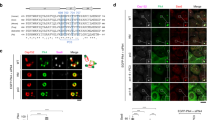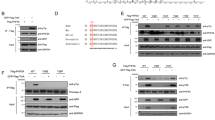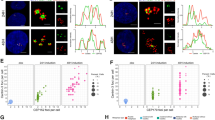Abstract
CDK2-cyclin E triggers centrosome duplication, and nucleophosmin (NPM/B23) is found to be one of its targets. NPM/B23 phosphorylated by CDK2-cyclin E acquires a high binding affinity to Rho-associated kinase (ROCK II), and physically associates with ROCK II. The NPM/B23-binding results in superactivation of ROCK II, which is a critical event for initiation of centrosome duplication. The activation of ROCK II also requires the binding of Rho small GTPase to the auto-inhibitory region; hence the availability of the active Rho protein is an important aspect of the centrosomally localized ROCK II to properly initiate centrosome duplication. There are three isoforms of Rho (RhoA, B and C), all of which are capable of binding to and priming the activation of ROCK II. Here, we investigated which Rho isoform(s) are involved in the activation of ROCK II in respect to the initiation of centrosome duplication. We found that both RhoA and RhoC, but not RhoB, were required for initiation of centrosome duplication, and overactivation of RhoA, as well as RhoC, but not RhoB, promoted centrosome duplication and centrosome amplification.
This is a preview of subscription content, access via your institution
Access options
Subscribe to this journal
Receive 50 print issues and online access
$259.00 per year
only $5.18 per issue
Buy this article
- Purchase on Springer Link
- Instant access to full article PDF
Prices may be subject to local taxes which are calculated during checkout





Similar content being viewed by others
References
Aoki T, Ueda S, Kataoka T, Satoh T . (2009). Regulation of mitotic spindle formation by the RhoA guanine nucleotide exchange factor ARHGEF10. BMC Cell Biol 28: 56.
Balczon R, Bao L, Zimmer WE, Brown K, Zinkowski RP, Brinkley BR . (1995). Dissociation of centrosome replication events from cycles of DNA synthesis and mitotic division in hydroxyurea-arrested Chinese hamster ovary cells. J Cell Biol 130: 105–115.
Bishop AL, Hall A . (2000). Rho GTPases and their effector proteins. Biochem J 348: 241–255.
Canguilhem B, Pradines A, Baudouin C, Boby C, Lajoie-Mazenc I, Charveron M et al. (2005). RhoB protects human keratinocytes from UVB-induced apoptosis through epidermal growth factor receptor signaling. J Biol Chem 280: 43257–43263.
Chen Z, Indjeian VB, McManus M, Wang L, Dynlacht BD . (2002). CP110, a cell cycle-dependent CDK substrate, regulates centrosome duplication in human cells. Dev Cell 3: 339–350.
Chevrier V, Piel M, Collomb N, Saoudi Y, Frank R, Paintrand M et al. (2002). The Rho-associated protein kinase p160ROCK is required for centrosome positioning. J Cell Biol 157: 807–817.
D′Assoro AB, Lingle WL, Salisbury JL . (2002). Centrosome amplification and the development of cancer. Oncogene 40: 6146–6153.
Doxsey S . (2001). Re-evaluating centrosome function. Nature Rev Mol Cell Biol 2: 688–698.
Ellenbroek SI, Collard JG . (2007). Rho GTPases: functions and association with cancer. Clin Exp Metastasis 24: 657–672.
Fisk HA, Winey M . (2001). The mouse Mps1p-like kinase regulates centrosome duplication. Cell 106: 95–104.
Fukasawa K . (2005). Centrosome amplification, chromosome instability and cancer development. Cancer Lett 230: 6–19.
Fukasawa K . (2007). Oncogenes and tumour suppressors take on centrosomes. Nat Rev Cancer 7: 911–924.
Gómez del Pulgar T, Benitah SA, Valerón PF, Espina C, Lacal JC . (2005). Rho GTPase expression in tumourigenesis: evidence for a significant link. Bioessays 27: 602–613.
Hinchcliffe EH, Li C, Thompson EA, Maller JL, Sluder G . (1999). Requirement of Cdk2-cyclin E activity for repeated centrosome reproduction in Xenopus egg extracts. Science 283: 851–854.
Hinchcliffe EH, Sluder G . (2002). Two for two: Cdk2 and its role in centrosome doubling. Oncogene 21: 6154–6160.
Ho TT, Merajver SD, Lapière CM, Nusgens BV, Deroanne CF . (2008). RhoA-GDP regulates RhoB protein stability. Potential involvement of RhoGDIalpha. J Biol Chem 283: 21588–21598.
Kabuyama Y, Litman ES, Templeton PD, Metzner SI, Witze ES, Argast GM et al. (2009). A mediator of Rho-dependent invasion moonlights as a methionine salvage enzyme. Mol Cell Proteomics 8: 2308–2320.
Kjoller L, Hall A . (1999). Signalling to Rho GTPases. Exp Cell Res 253: 166–179.
Lacey KR, Jackson PK, Stearns T . (1999). Cyclin-dependent kinase control of centrosome duplication. Proc Natl Acad Sci USA 96: 2817–2822.
Ma Z, Kanai M, Kawamura K, Kaibuchi K, Ye K, Fukasawa K . (2006). Interaction between ROCK II and nucleophosmin/B23 in the regulation of centrosome duplication. Mol Cell Biol 26: 9016–9034.
Matsui T, Amano M, Yamamoto T, Chihara K, Nakafuku M, Ito M et al. (1996). Rho-associated kinase, a novel serine/threonine kinase, as a putative target for small GTP binding protein Rho. EMBO J 15: 2208–2216.
Matsumoto Y, Hayashi K, Nishida E . (1999). Cyclin-dependent kinase 2 (Cdk2) is required for centrosome duplication in mammalian cells. Curr Biol 9: 429–432.
Milia J, Teyssier F, Dalenc F, Ader I, Delmas C, Pradines A et al. (2005). Farnesylated RhoB inhibits radiation-induced mitotic cell death and controls radiation-induced centrosome overduplication. Cell Death Differ 12: 492–501.
Morgan DO . (1997). Cyclin-dependent kinases: engines, clocks, and microprocessors. Annu Rev Cell Dev Biol 13: 261–291.
Nakagawa O, Fujisawa K, Ishizaki T, Saito Y, Nakao K, Narumiya S . (1996). ROCK-I and ROCK-II, two isoforms of Rho-associated coiled-coil forming protein serine/threonine kinase in mice. FEBS Lett 392: 189–193.
Okuda M, Horn HF, Tarapore P, Tokuyama Y, Smulian AG, Chan PK et al. (2000). Nucleophosmin/B23 is a target of CDK2/cyclin E in centrosome duplication. Cell 103: 127–140.
Reed SI . (1997). Control of the G1/S transition. Cancer Surv 29: 7–23.
Sahai E, Alberts AS, Treisman R . (1998). RhoA effector mutants reveal distinct effector pathways for cytoskeletal reorganization, SRF activation and transformation. EMBO J 17: 1350–1361.
Salisbury JL . (2007). A mechanistic view on the evolutionary origin for centrin-based control of centriole duplication. J Cell Physiol 213: 420–428.
Shinomiya N, Gao CF, Xie Q, Gustafson M, Waters DJ, Zhang YW et al. (2004). RNA interference reveals that ligand-independent met activity is required for tumor cell signaling and survival. Cancer Res 64: 7962–7970.
Simpson KJ, Dugan AS, Mercurio AM . (2004). Functional analysis of the contribution of RhoA and RhoC GTPases to invasive breast carcinoma. Cancer Res 64: 8694–8701.
Tarapore P, Horn HF, Tokuyama Y, Fukasawa K . (2001). Direct regulation of the centrosome duplication cycle by the p53-p21Waf1/Cip1 pathway. Oncogene 20: 3173–3184.
Tarapore P, Okuda M, Fukasawa K . (2002). A mammalian in vitro centriole duplication system: evidence for involvement of CDK2/cyclin E and nucleophosmin/B23 in centrosome duplication. Cell Cycle 1: 75–81.
Tokuyama Y, Horn HF, Kawamura K, Tarapore P, Fukasawa K . (2001). Specific phosphorylation of nucleophosmin on Thr(199) by cyclin-dependent kinase 2-cyclin E and its role in centrosome duplication. J Biol Chem 276: 21529–21537.
Vega FM, Ridley AJ . (2008). RhoGTPases in cancer cell biology. FEBS lett 582: 2093–2101.
Wang HR, Zhang Y, Ozdamar B, Ogunjimi AA, Alexandrova E, Thomsen GH et al. (2003a). Regulation of cell polarity and protrusion formation by targeting RhoA for degradation. Science 302: 1775–1779.
Wang L, Yang L, Luo Y, Zheng Y . (2003b). A novel strategy for specifically down-regulating individual Rho GTPase activity in tumor cells. J Biol Chem 278: 44617–44625.
Wheeler AP, Ridley AJ . (2004). Why three Rho proteins? RhoA, RhoB, RhoC, and cell motility. Exp Cell Res 301: 43–49.
Wolf A, Keil R, Götzl O, Mun A, Schwarze K, Lederer M et al. (2006). The armadillo protein p0071 regulates Rho signaling during cytokinesis. Nat Cell Biol 8: 1432–1440.
Acknowledgements
We thank M Rowland and B Nepon-Sixt for technical assistance and core staff at the analytical microscopy core facility and molecular biology core facility in H Lee Moffitt Cancer Center. We also thank Dr Sebti for providing RhoB cDNA. This study is supported by the National Institute of Health (CA90522 to KF) and James & Esther King Biomedical Research Program (09KN-05–23139 to MK).
Author information
Authors and Affiliations
Corresponding author
Ethics declarations
Competing interests
The authors declare no conflict of interest.
Additional information
Supplementary Information accompanies the paper on the Oncogene website
Rights and permissions
About this article
Cite this article
Kanai, M., Crowe, M., Zheng, Y. et al. RhoA and RhoC are both required for the ROCK II-dependent promotion of centrosome duplication. Oncogene 29, 6040–6050 (2010). https://doi.org/10.1038/onc.2010.328
Received:
Revised:
Accepted:
Published:
Issue Date:
DOI: https://doi.org/10.1038/onc.2010.328
Keywords
This article is cited by
-
Activation of RhoC by regulatory ubiquitination is mediated by LNX1 and suppressed by LIS1
Scientific Reports (2022)
-
Aberrant Activation of Cell Cycle Regulators, Centrosome Amplification, and Mitotic Defects
Hormones and Cancer (2011)



